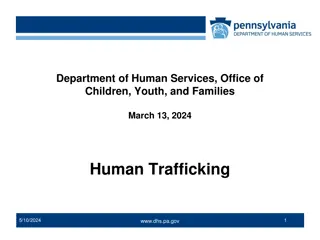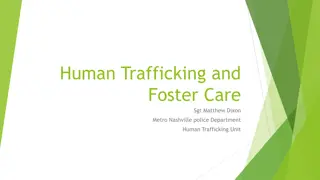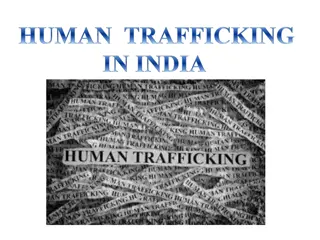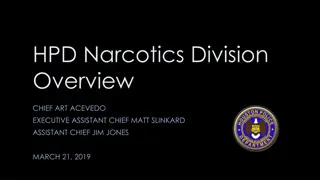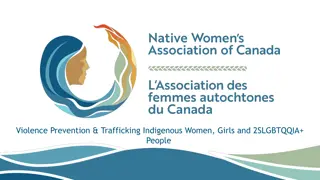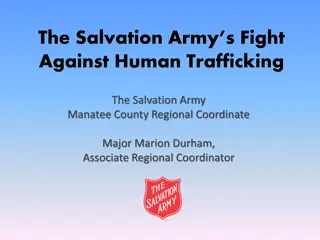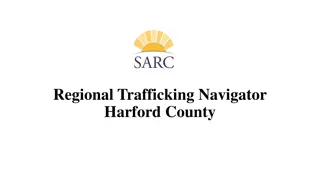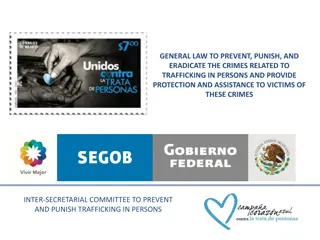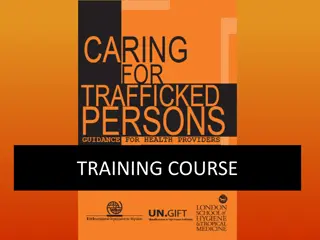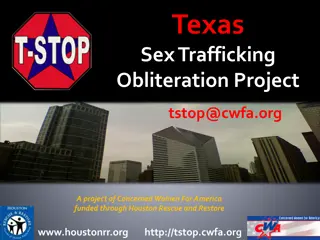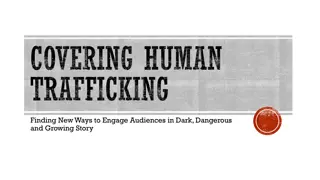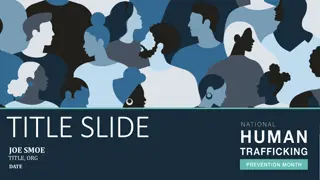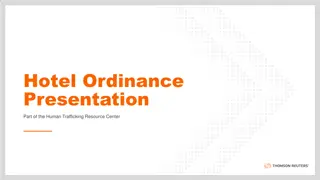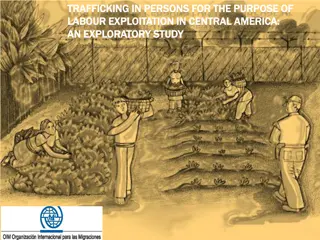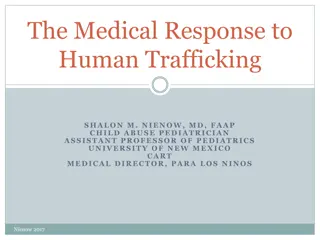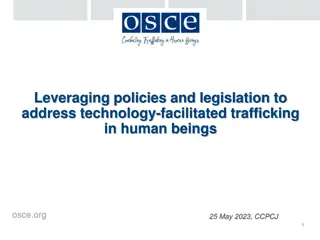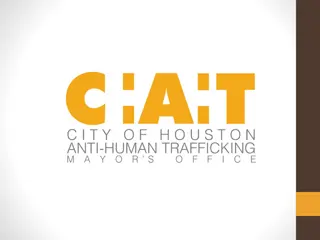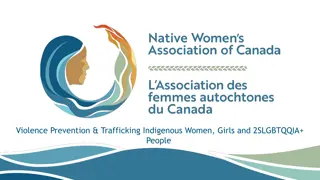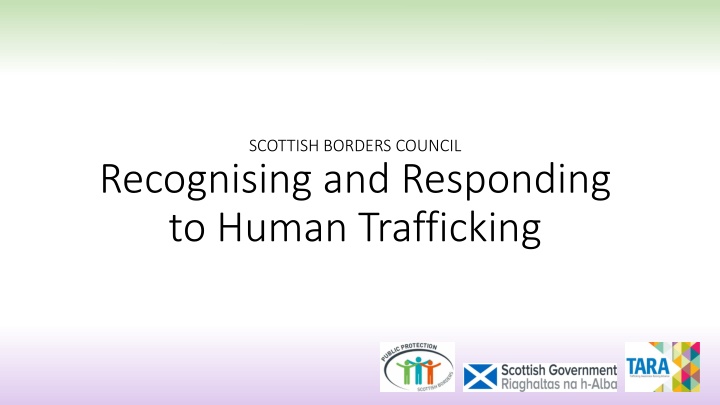
Responding to Human Trafficking in Scottish Borders Council
Gain knowledge and skills to recognize and respond to human trafficking in the Scottish Borders Council area. Understand the difference between human trafficking and people smuggling, learn about the relevant actions and intentions in the offense of human trafficking, and discover the challenges it poses for law enforcement and public services.
Download Presentation

Please find below an Image/Link to download the presentation.
The content on the website is provided AS IS for your information and personal use only. It may not be sold, licensed, or shared on other websites without obtaining consent from the author. If you encounter any issues during the download, it is possible that the publisher has removed the file from their server.
You are allowed to download the files provided on this website for personal or commercial use, subject to the condition that they are used lawfully. All files are the property of their respective owners.
The content on the website is provided AS IS for your information and personal use only. It may not be sold, licensed, or shared on other websites without obtaining consent from the author.
E N D
Presentation Transcript
SCOTTISH BORDERS COUNCIL Recognising and Responding to Human Trafficking
Aims & Outcomes This course will provide you with information to enable you to recognise and respond to human trafficking. By the end of it, you should have a knowledge and understanding that will enable you to: Describe what it is Recognise and identify key indicators of human trafficking Know what actions you should take if you suspect human trafficking
Introduction Trafficking in human beings is a global phenomenon which causes misery and suffering to victims throughout the world, both in developed and developing countries. Human trafficking is referred to as a hidden crime , an area of criminality that can take many forms, involving a wide variety of offending, making it difficult to fully understand. What you need to know is that human trafficking is happening in urban and rural Scotland, involving not only foreign nationals, but British nationals as well. Human trafficking creates significant challenges for Scottish law- enforcement, public sector services, non-governmental organisations, as well as to the public.
Human Trafficking v People Smuggling Human trafficking should not be confused with people smuggling. Smuggling is a crime against the state, trafficking is a crime against the person. A trafficked victim and smuggled person may have entered the country by the same means i.e. the same container in the back of the same lorry, however upon arrival at their destination, the smuggled person is free to go about their own business, the trafficked person is not. It may be that a trafficked victim initially thought that they were being smuggled, but this arrangement has changed and they are subject to exploitation.
The offence of human trafficking As per the Human Trafficking and Exploitation (Scotland) Act 2015 There are two parts to the offence the relevant action and an intention to exploit or knowledge of likely exploitation. Both are needed for an offence to be committed. It does not matter whether the other person consents to the action being taken when carrying out a relevant action. The person doing the relevant action must either be doing so with the intention of exploiting the other person or, in the knowledge that the person is likely to be exploited
Relevant Action As per the Human Trafficking and Exploitation (Scotland) Act 2015 Recruiting another person Transporting or transferring another person Harbouring or receiving another person Exchanging control over, or transferring control over another person Arranging or facilitating (without necessarily doing) any of the actions above
Intention to Exploit, or Knowledge of Likely Exploitation The Human Trafficking and Exploitation (Scotland) Act 2015 defines 4 types of exploitation: Slavery, servitude and forced or compulsory labour; Prostitution or sexual exploitation; Removal of organs Securing services and benefits
Trafficking within UK Borders Trafficking does not have to be international and it happens within the UK including by and to British nationals. This includes moving a victim: From one town to another in Scotland/UK From one street to another within the same town From one room to another within the same property Transfer or exchange of control of another person within the same room
Traffickers Traffickers might be: Part of a well-organised criminal network OR Individuals, involved in only one of the various stages of the operation A person can potentially be convicted of trafficking even if they are only involved in part of the process.
Who do traffickers prey on? Anyone can become a victim of human trafficking, but usually the most vulnerable are targeted. Traffickers are known to target poverty, disaster and dreams. Trafficking is the EXPLOITATION of victims and can take many forms. Human trafficking always involves exploitation of some kind, or the intention to exploit. Be aware there are a wide variety of circumstances which may lead to the person falling victim of human trafficking.
VICTIMS UK National Referral Mechanism (NRM) statistics for 2023 show that: 17,004 cases of trafficking reported UK wide 765 of these were in Scotland 161 female 81 adults (18 or over), 72 children (17 or under), 8 not specified 604 male 336 adults (18 or over), 234 children (17 or under), 34 not specified
VICTIMS UK National Referral Mechanism (NRM) statistics for 2023 show that the top 3 nationalities of ALL those reported as victims of trafficking are:
VICTIMS - ADULTS UK National Referral Mechanism (NRM) statistics for 2023 show that the top 3 nationalities of ADULTS reported as victims of trafficking are:
VICTIMS - CHILDREN UK National Referral Mechanism (NRM) statistics for 2023 show that the top 3 nationalities of CHILDREN reported as victims of trafficking are:
Breakdown of AGE of victims Source: UK National Referral Mechanism (NRM) statistics for 2023
Breakdown of SEX and AGE of victims Source: UK National Referral Mechanism (NRM) statistics for 2023
How to identify human trafficking victims Human trafficking will often not simply present itself to you. In order to identify trafficking you must be aware of how to recognise the signs of trafficking and be prepared to actively look further into these indicators. Many victims will not disclose, or may not even know that they are a victim. Victims are often from communities that are hidden, such as foreign- language speaking communities or communities with an unstable UK immigration status. Victims of trafficking may come to light during the investigation of other circumstances e.g. domestic abuse, fraud or benefit application. To be able to identify a victim, you should be aware of the indicators, as well as methods of control, which can also indicate a victim of trafficking.
Methods of Control Victims of trafficking are controlled at all times by the traffickers. The methods of control may change over time and can include:
GENERAL TRAFFICKING AND METHODS OF CONTROL INDICATORS INSERT VIDEO Free the unseen. - YouTube
Local Authority Involvement Local Authority staff may often find themselves in contact with people who could potentially be victims. These staff include social workers, youth teams, environmental health officers and other frontline staff. Scottish Borders Council are a Frontline organisation and have a duty of care to report a case, or suspected case of human trafficking. Local authorities are unlikely to play a key role in identifying and catching traffickers. However, they will be instrumental in gathering evidence from the victims about the traffickers and may find themselves involved in court cases against traffickers. Under the National Referral Mechanism (NRM) all Local Authorities are First Responders
What Support/Advice can SBC offer? Councils have a duty to provide assistance to trafficked children in their area; adult victims who are foreign nationals, may not have recourse to public funds but local authority assistance can be provided on a discretionary basis. Scottish Borders Council has a dedicated First Responder Team which is made up of Adult Protection and Child Protection Officers, based in the Public Protection Unit. First Responders are responsible for supporting the national pathway to identification and protection by: Identifying potential victims Explaining the support available and gaining consent, where applicable Referring them into the NRM, where appropriate Safeguarding individuals Seeking legal advice as soon as practicably possible
SBC REFERRAL PROCESS You don t need to be certain someone is a victim. If you think you have encountered a person who has been a victim of human trafficking in the Scottish borders, you should contact the phone numbers below and the information will be passed on to the First Responder Team for action. Potential adult victim identified call 0300 100 1800 Potential child victim identified call 01896 662787 Out of Hours (for adult or child) call Emergency Duty Team 01896 752111 Potential victim identified in an emergency call Police on 999
What is being done in Scotland about Trafficking? Human Trafficking and Exploitation (Scotland) Act 2015 new offences, new powers for police and prosecutors Human Trafficking and Exploitation Strategy* published May 2017 includes action on: Identifying victims and supporting them to safety and recovery Identifying perpetrators and disrupting their activity Addressing conditions that foster trafficking and exploitation Specific measures to address child trafficking *The Strategy is being refreshed during 2024 by the Scottish Government and anti-trafficking partners
Contacts and Other Resources Children 1st(Scottish Borders) 01750 22892 ettrick@children1st.org.uk Provides support to children and young people up to the age of 18 within the Scottish Borders, who are victims of trafficking. Migrant Help 0141 884 7900 (daytime) 0141 212 8553 (OoH) Protects people affected by displacement and exploitation, helping them thrive as individuals and recover from their trauma. Scottish Government human.trafficking@gov.scot Provides victims with online help, support, advice and signposting to other agencies TARA 0141 276 7724 (24/7) Provides support to women aged 18 years and over, who have been trafficked for the purposes of commercial sexual exploitation.

